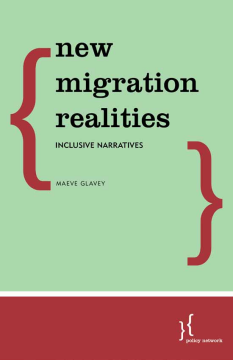
Additional Information
Book Details
Abstract
Immigration to the UK has been growing in recent years, reaching its highest level on record in 2016. As the figures have increased, so have popular concerns about pressure on public services and the impact on British identity and social cohesion. The Brexit vote highlighted more than ever before the urgency of addressing these concerns if the UK is to remain a tolerant and open society.
Across Europe in the context of the recent refugee crisis and terrorist attacks, resentment towards immigration has also been growing. Populist parties have seized on immigration and integration to magnify their voices and increasingly challenge mainstream parties.
This publication is the culmination of a 12-month comparative research project exploring the similarities and differences in narratives on immigration in the UK and three north-western European countries – France, Germany and Sweden. It explores what the UK can learn from its European neighbours, and how we can come up with new inclusive narratives and policy actions, which at the same time take account of people's concerns about immigration and integration in a changing world.
Maeve Glavey is a Researcher at Policy Network. She coordinates the Barrow Cadbury Trust research project on migration, exploring the reaction of mainstream political parties, governments in Western Europe and populist movements to current migration trends.
Table of Contents
| Section Title | Page | Action | Price |
|---|---|---|---|
| Cover | Cover | ||
| NEW MIGRATION REALITIES | i | ||
| NEW MIGRATION REALITIES | iii | ||
| CONTENTS | v | ||
| LIST OF FIGURES | vii | ||
| ACKNOWLEDGEMENTS | ix | ||
| INTRODUCTION | 1 | ||
| GLOBAL MIGRATION | 3 | ||
| IMMIGRATION AFTER BREXIT | 4 | ||
| CHARTING A NEW PATH | 6 | ||
| EXISTING NARRATIVES | 9 | ||
| POLITICS AND POLICY ON IMMIGRATION SINCE 1945 | 10 | ||
| THE RISE OF THE FAR RIGHT: DETOXIFICATION AND INCREASED FOCUS ON IMMIGRATION | 18 | ||
| ELEMENTS OF THE ANTI-IMMIGRATION NARRATIVE | 21 | ||
| ISLAM, SECURITY AND INTEGRATION | 27 | ||
| FAILED NARRATIVES AND FIGHTING BACK | 30 | ||
| NOTES | 31 | ||
| ATTITUDES AND CONCERNS ABOUT IMMIGRATION | 33 | ||
| WHO’S ON THE MOVE? OLD AND NEW PATTERNS | 34 | ||
| GENERAL ATTITUDES TO IMMIGRATION | 37 | ||
| WHAT ARE PEOPLE WORRIED ABOUT? | 38 | ||
| ATTITUDES TOWARDS PARTICULAR GROUPS | 41 | ||
| ATTITUDES AND ISLAM | 43 | ||
| WHO IS DOING THE WORRYING? | 47 | ||
| WHERE DOES THIS LEAVE US? | 50 | ||
| NOTES | 52 | ||
| CASE STUDIES | 53 | ||
| TAKING CONTROL: GOVERNMENT ACTION AND LEGISLATION | 54 | ||
| GERMANY: ACTION ON INTEGRATION | 55 | ||
| SWEDEN: 21 POLICIES FROM ARRIVAL TO INTEGRATION | 59 | ||
| HELPING NEWCOMERS CONTRIBUTE AND FIT IN: FURTHER ACTION ON LABOUR MARKET ACCESS AND LANGUAGE CLASSES IN SWEDEN | 61 | ||
| SNABBSPÅRET’: MATCHING SKILLED MIGRANTS TO JOBS | 62 | ||
| SVENSKUNDERVISNING FÖR INVANDRARE’: BOOSTING LANGUAGE SKILLS | 63 | ||
| CONNECTING WITH THE PUBLIC: PROMOTING DEMOCRACY AND SOCIAL COHESION | 66 | ||
| FRANCE: FRANCE TERRE D’ASILE | 66 | ||
| FOSTERING PARTNERSHIPS | 66 | ||
| DEMOKRATIE LEBEN’ | 69 | ||
| COUNTERING RIGHTWING EXTREMISM | 69 | ||
| GERMANY: | 69 | ||
| SVERIGE TILLSAMMANS’ | 71 | ||
| PROVIDING INFORMATION AND SHARING BEST PRACTICE | 71 | ||
| SWEDEN: | 71 | ||
| SWEDEN: SALAR IDEAS BANK | 74 | ||
| NEW NARRATIVES | 75 | ||
| PRINCIPLES Reclaim Language and Identity Politics | 76 | ||
| Government Should Provide Central Leadership But Involve Stakeholders | 79 | ||
| Approach Immigration and Integration Strategically | 80 | ||
| COMMUNICATE CLEARLY, EFFECTIVELY AND TRANSPARENTLY | 83 | ||
| RECOMMENDATIONS | 84 | ||
| Actions for Government | 84 | ||
| Actions for Regulators | 87 | ||
| Actions for Civil Society and Business | 88 | ||
| Cooperating with Europe | 91 | ||
| NOTES | 91 | ||
| CONCLUSION | 93 | ||
| REFERENCES | 97 |
